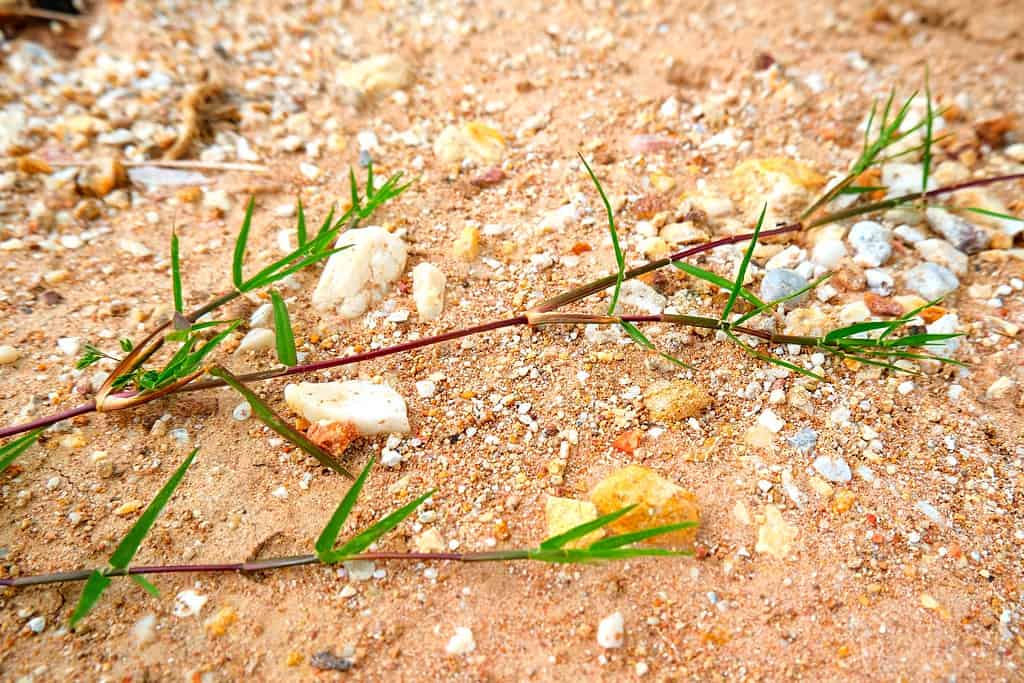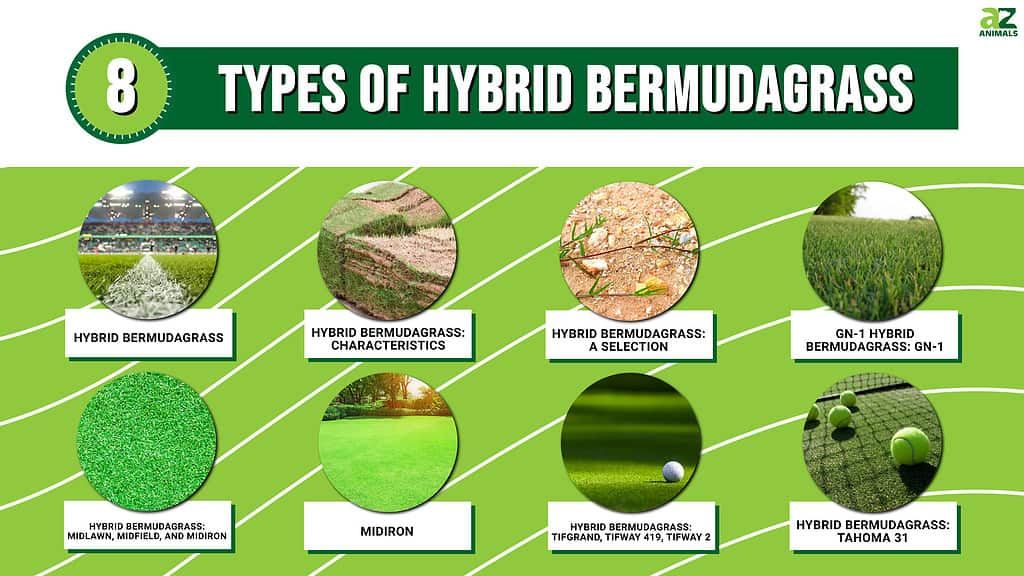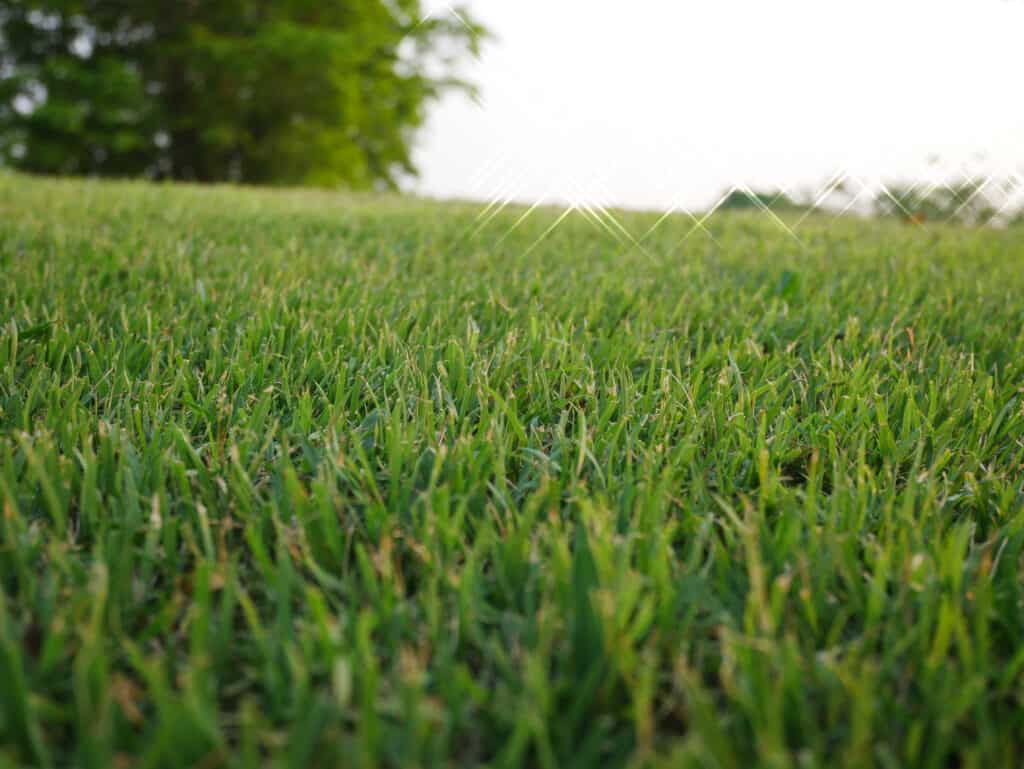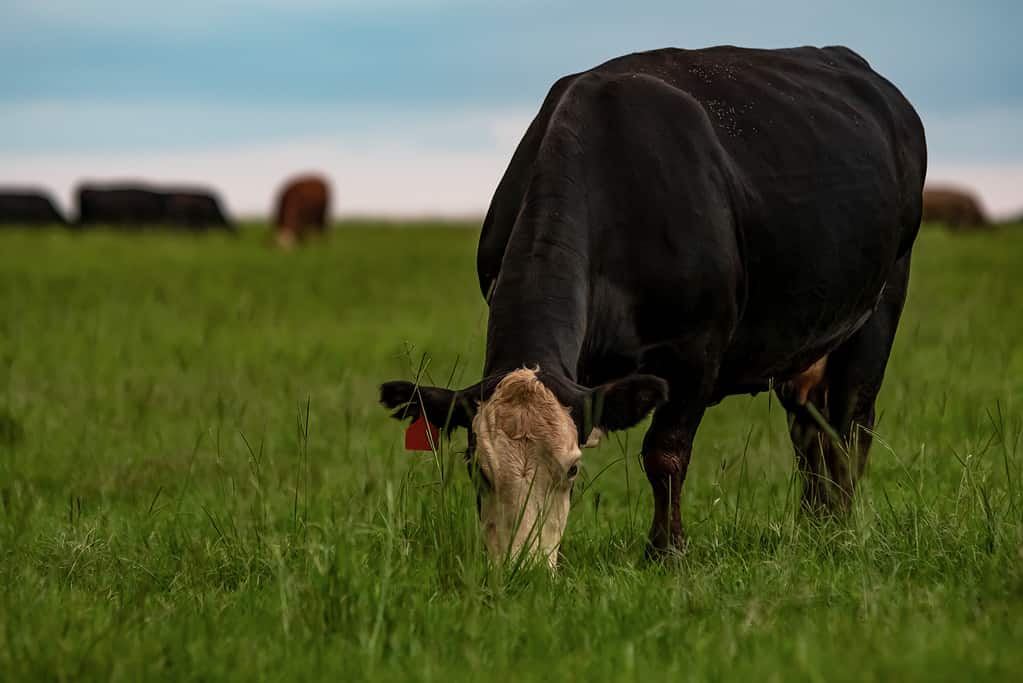Hybrid Bermudagrass (Cynodon dactylon x Cynodon transvaalensis) is an interspecific hybrid between common bermudagrass (Cynodon dactylon) and African bermudagrass (Cynodon transvaalensis). This hybrid was developed in the 1940s and 1950s by plant breeders who were seeking a turfgrass that combined the desirable characteristics of both parent species, such as drought tolerance, disease resistance, and a finer leaf texture. The resulting hybrid bermudagrass has become a popular choice for golf courses, sports fields, and residential lawns in warm climates. From personal lawns to commercial sports fields and golf courses, hybrid bermudagrass has become the go-to choice for people who desire lush, green turf that can withstand a wide range of environmental stresses.

Hybrid bermudagrass is typically used for high-traffic areas, such as athletic fields, golf courses, and parks.
©Lukasz Libuszewski/Shutterstock.com
Hybrid bermudagrass cultivars do not produce viable seeds. Therefore, to propagate hybrid bermudagrass, vegetative methods such as sprigging or sodding must be employed instead. This involves planting pieces of the stolons (runners) or rhizomes (roots) of the hybrid bermudagrass to establish a new plant. These methods allow for the maintenance of the genetic integrity and desirable characteristics of the cultivar. Hybrid bermudagrass is typically used for high-traffic areas, like athletic fields, golf courses, and parks. It is recognized for its durability, fast growth, and ability to recover quickly from damage. There are many different hybrid bermudagrass varieties available, each with its own characteristics and applications. Keep reading to discover eight types of hybrid bermudagrass while finding a variety that’s right for you!

Hybrid bermudagrass cultivars do not produce viable seeds. Therefore, to propagate hybrid bermudagrass, vegetative methods such as sprigging or sodding must be employed instead.
©MarinaDphotography/Shutterstock.com
Hybrid Bermudagrass: Characteristics
Since its inception, hybrid bermudagrass has been introduced and widely cultivated in many parts of the world. Characteristics of hybrid bermudagrass are:
- Leaf blades: Hybrid bermudagrass leaves are flat, narrow, and have a pointed tip. The leaf blades are typically 0.07-0.5 inches (2-15 mm) wide and up to 1 inch (25 cm) long.
- Stem: Hybrid bermudagrass stems are usually flat and can range from green to purplish-red in color. The prostrate stems can grow up to 3 feet (1 m) long. They can root at the nodes to form new plants.
- Roots: Hybrid bermudagrass has a shallow root system that can grow up to 3 feet (1 m) deep in well-drained soils. The roots are fibrous and can spread horizontally to form a dense turf.
- Flowering: Hybrid bermudagrass produces very few seedheads, and those it does produce are not viable.
- Growth habit: Hybrid bermudagrass is a fast-growing grass that can spread quickly through runners (stolons) and rhizomes (roots). It is tolerant of heat, drought, and foot traffic. This makes it a popular choice for lawns, athletic fields, and golf courses.
- Appearance: Bermudagrass has a medium to fine texture and a dark green color. It can be mowed to a wide range of heights, depending on the intended use and desired appearance.

Bermudagrass is a fast-growing grass that can spread quickly through runners (stolons).
©Theeraya Nanta/Shutterstock.com

The Mid cultivars are drought-tolerant, wear-tolerant, and disease-resistant, making them well-suited for use on golf courses, sports fields, and residential lawns in warm climates.
Hybrid Bermudagrass: A Selection
There are dozens of varieties of bermudagrass. We will concentrate on eight of the most well-known, popular, and readily available varieties. Of note: Hybrid bermudagrass varieties can be more expensive than other types of grass. They may require specialized maintenance and care to keep them healthy and vibrant.
GN-1 Hybrid Bermudagrass: GN-1
GN-1 is an excellent choice for people who want a cold-tolerant bermudagrass with good turf quality and durability. This hybrid bermudagrass was developed by Greg Norman Turf Farms, located in Avon Park, Florida. The grass was developed through a collaboration between Greg Norman Turf Farms and the University of Georgia’s Turfgrass Breeding Program. GN-1 is a popular choice for golf courses, sports fields, and other high-traffic turfgrass areas. It has excellent wear tolerance, disease resistance, and the ability to recover quickly from damage. It is also known for its dark green color, fine leaf texture, and drought tolerance. GN-1 is a dense, fine-textured grass. It has excellent turf quality and good resistance to diseases such as brown patches and dollar spots.
GN-1 has a high level of cold tolerance. This allows it to remain green longer into the fall and green up earlier in the spring. GN-1 is an attractive option for homeowners who desire year-round greenery and for sports field managers who need grass that can withstand early spring and late fall games. GN-1 hybrid bermudagrass can survive in USDA Hardiness Zones 6-11. You can discover your USDA Hardiness Zone here.

Hybrid bermudagrass varieties can be more expensive than other types of grass and may require specialized maintenance and care to keep them healthy and vibrant.
©Joyjiraporn/Shutterstock.com
Hybrid Bermudagrass: Midlawn, Midfield, and Midiron
The Mid cultivars of hybrid bermudagrass are a group of turfgrass varieties that were developed for their intermediate growth habit, which means that they are more upright in growth and produce a denser, more uniform turf with a finer texture than some other hybrid bermudagrass cultivars. The Mid cultivars are also drought-tolerant, wear-tolerant, and disease-resistant, making them well-suited for use on golf courses, sports fields, and residential lawns in warm climates.
Midlawn
The first Mid cultivar, Midlawn, was developed at the United States Department of Agriculture (USDA) research station in Tifton, Georgia in the 1950s. Midlawn is known for its dense, fine-textured turf and its ability to tolerate heavy foot traffic and wear. It is also drought-tolerant and requires less water than some other warm-season turfgrass species. Midlawn has been widely used on golf course fairways, tees, and roughs, as well as on sports fields and residential lawns in warm climates. Its dense growth habit and fine texture make it well-suited for use in areas with heavy foot traffic, while its drought tolerance and low water requirements make it an attractive option in areas where water is a concern.

Midlawn is known for its dense, fine-textured turf and its ability to tolerate heavy foot traffic and wear.
©janniwet/Shutterstock.com
Midfield
Another type of hybrid bermudagrass, Midfield was developed at the Kansas State University Polycross Nursery in Fort Hayes, Kansas. It has a medium texture and good density, which makes it an ideal choice for sports fields and golf courses. It has good tolerance to drought, heat, and wear and tear, and it recovers quickly from injury. Midfield is suitable for use in USDA hardiness zones 7-11. It is durable, resilient, and easy to maintain, making it an attractive option for people who want high-quality turfgrass that can withstand heavy use and harsh conditions.

Midfield is an attractive option for people who want high-quality turfgrass that can withstand heavy use and harsh conditions.
©aimful/Shutterstock.com
Midiron
Midiron bermudagrass was developed in the 1960s by the United States Department of Agriculture (USDA) and the University of Georgia. It is a hybrid bermudagrass cultivar that was bred for its superior turfgrass characteristics, including a fine texture, high density, and good wear tolerance.
Midiron bermudagrass is known for its rapid growth and establishment, making it a popular choice for use on golf courses, sports fields, and residential lawns. It is also relatively drought-tolerant and can withstand heavy foot traffic and mechanical wear.

Midiron bermudagrass is known for its rapid growth and establishment, making it a popular choice for use on golf courses.
©Branko Jovanovic/Shutterstock.com
Hybrid Bermudagrass: Tifgrand, Tifway 419, Tifway 2
Tifgrand, Tifway, and Tifway II are all types of hybrid bermudagrass that were developed by the United States Department of Agriculture (USDA) and the Georgia Coastal Plain Experiment Station. The Tif- prefix in many bermudagrass varieties refers to Tifton, Georgia, where the USDA developed and released several successful cultivars. These cultivars were then used as parents in breeding programs to create new varieties, and the Tif name was often carried forward to indicate their Tifton origins. For example, Tifway 419, TifSport, and TifGrand are all bermudagrass varieties that were developed in Tifton, Georgia or have parentage from Tifton cultivars
Tifgrand
TifGrand (PP21017) is a hybrid bermudagrass variety that was developed by the University of Georgia’s turfgrass breeding program. This cultivar is known for its dark green color, fine texture, and exceptional drought tolerance. It has a high density and can tolerate heavy traffic and wear, making it a popular choice for sports fields, golf courses, and parks. TifGrand also has good resistance to many common turfgrass diseases and pests, which can help reduce the need for chemical treatments and other forms of maintenance.
One of the features of TifGrand is its shade tolerance. Compared to other bermudagrass varieties, TifGrand is able to tolerate significantly more shade and still maintain its density and quality. This makes it a popular choice for areas with partial shade or where trees and other obstacles limit sunlight.
Its exceptional drought tolerance, traffic resistance, and shade tolerance make it a popular choice for both commercial and residential landscapes.

Its exceptional drought tolerance, traffic resistance, and shade tolerance make Tifgrand a popular choice for both commercial and residential landscapes.
©Zenzeta/Shutterstock.com
Tifway 419
Tifway is a popular hybrid bermudagrass variety that was developed by Dr. Glenn Burton in 1960 when he was working for the US Department of Agriculture in cooperation with the Georgia Coastal Plain Experiment Station and the University of Georgia. Also known as Tifway 419, Tifway was released in 1960 and quickly became a popular choice for golf courses, athletic fields, and home lawns due to its fine texture, dense growth habit, and excellent wear tolerance. It is a cross between a common bermudagrass and an African bermudagrass. Tifway 419 was used in Super Bowl XII in 1978. It has also been used in several other Super Bowls, including Super Bowls XVI, XX, XXII, XXVIII, XXX, and XXXIII.

Tifway 419 was used in Super Bowl XII in 1978. It has also been used in several other Super Bowls, including Super Bowls XVI, XX, XXII, XXVIII, XXX, and XXXIII.
©wanpatsorn/Shutterstock.com
Tifway 2
This hybrid bermudagrass, released in 2001, is a newer version of Tifway 419. Tifway 2 was developed to be more disease-resistant and require less maintenance than Tifway 419. It has similar characteristics to Tifway 419 but with improved tolerance to diseases like Spring Dead Spot and Leaf Spot. Tifway 2 has become a popular choice for golf courses, sports fields, and residential lawns. Both Tifway and Tifway 2 are warm-season grasses that thrive in full sun and warm temperatures. They are known for their ability to tolerate heavy foot traffic and recover quickly from damage.

Tifway 2 has become a popular choice for golf courses, and sports fields.
©kireewong foto/Shutterstock.com
Hybrid Bermudagrass: Tahoma 31
Tahoma 31 bermudagrass, is a variety of hybrid bermudagrass that was developed by Oklahoma State University and released in 1997. Tahoma 31 was specifically developed for use on athletic fields, particularly football fields, due to its excellent wear tolerance, rapid recovery from injury, and dense growth habit. It is also resistant to many common turfgrass diseases and can be maintained at a low mowing height. Tahoma 31 is also more cold-tolerant than many varieties of hybrid bermudagrass. It is a popular choice for high-traffic athletic fields across the United States.

Tahoma 31 bermudagrass was originally developed as a food source for cattle.
©JNix/Shutterstock.com
Tahoma 31 bermudagrass is a specific cultivar developed for use on athletic fields, particularly football fields. Its characteristics make it well-suited for such use, including its ability to withstand wear and tear, recover quickly from damage, and resist disease. It is also tolerant of close mowing and has a fine leaf texture, which can contribute to a high-quality playing surface. Tahoma 31 was used in Super Bowl 57 thanks to its reputation as a solid and dense turfgrass.
Summary of 8 Types of Hybrid Bermudagrass
| Number | Hybrid Bermudagrass |
|---|---|
| 1 | Hybrid Bermudagrass |
| 2 | Characteristics |
| 3 | A Selection |
| 4 | GN-1 |
| 5 | Midlawn, Midfield, and Midiron |
| 6 | Midiron |
| 7 | Tifgrand, Tifway 419, Tifway 2 |
| 8 | Tahoma 31 |
Thank you for reading! Have some feedback for us? Contact the AZ Animals editorial team.








